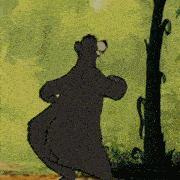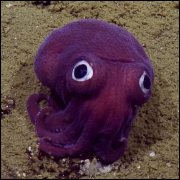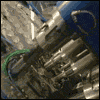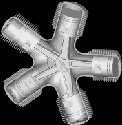|
The Oklahoma City Astronomy Club chartered a bus to St Joseph, MO to watch the total eclipse. It was 40 of us crammed into a bus on an overnight drive. It was a sleeper bus but I don't think anyone was able to actually sleep. Anyway, we mostly got clouded/rained out. I took a scope+camera but gave up trying to set it up because of the conditions. Instead, I made a video of our trip, including the "totality" that we did get to see. I had literally never shot video or made a video before, so there's a bunch of stuff that I wish I had done differently (something more stable than me swinging the camera around on a monopod, for starters), but it turned out OK for (again, literally) my first time shooting/making video. Anyway, it's something eclipse-related that's a bit different then close ups of the sun. Would have loved to make THAT video instead, but I'll try again in 2024 unless I can convince my wife to go to Chile in 2019. https://www.youtube.com/watch?v=DzxME9PbYfE
|
|
|
|

|
| # ? May 14, 2024 12:01 |
|
Interest in the eclipse helped bring back the astronomy interest I had as a kid. In those days, I had a small Jason Comet Chaser telescope that I really didn't know how to make use of. After looking at reviews online, I ordered a Astronomers Without Borders OneSky and look forward to seeing what I can tease out of the sky once it arrives in the next few weeks. I also ordered Turn Left at Orion. So now, are there any other books or accessories I should consider for later down the line?
|
|
|
|
I had a blast shooting the eclipse with my cheap 55-300mm telephoto, and I think I'm ready to maybe spend a little more money on something with further reach. It looks like $1k will get me a pretty nice 150-600mm telephoto. Are there any telescopes in that same $1k ballpark that would be good for primarily astrophotography use? Also I'm sure everyone is sick of them by now, but I'm still stoked about getting some good shots during totality for my first try. 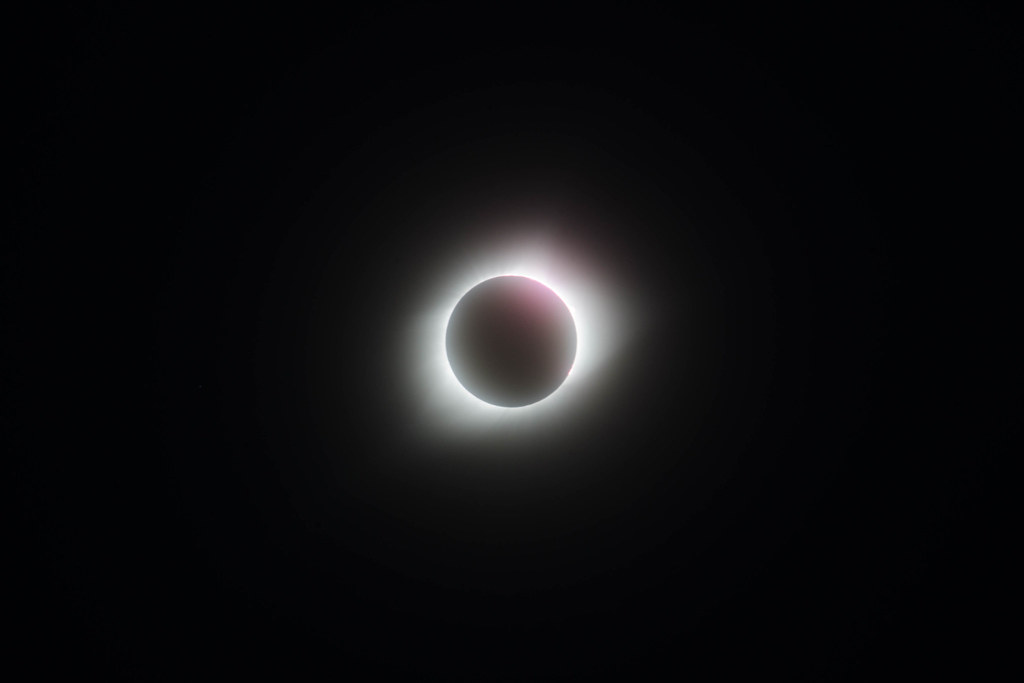 
|
|
|
|
Enos Cabell posted:I had a blast shooting the eclipse with my cheap 55-300mm telephoto, and I think I'm ready to maybe spend a little more money on something with further reach. It looks like $1k will get me a pretty nice 150-600mm telephoto. Are there any telescopes in that same $1k ballpark that would be good for primarily astrophotography use? I have this 80mm refractor and I like it quite a bit. https://www.bhphotovideo.com/c/product/735549-REG/Sky_Watcher_S11100_S11100_Pro_80ED_APO.html What's your mount situation though? Because I think for astrophotography, the mount is maybe more important than the telescope. Without a good solid tracking mount you won't be able to do long exposures reliably. You can do up to 300mm or so on a Skytracker (which is what I have) but past that you'll want a dedicated mount. While we're sharing eclipse photos, here are mine from totality in eastern TN. https://www.flickr.com/photos/jcurbo/albums/72157685154096231 
|
|
|
|
hannibal posted:I have this 80mm refractor and I like it quite a bit. https://www.bhphotovideo.com/c/product/735549-REG/Sky_Watcher_S11100_S11100_Pro_80ED_APO.html What's your mount situation though? Because I think for astrophotography, the mount is maybe more important than the telescope. Without a good solid tracking mount you won't be able to do long exposures reliably. You can do up to 300mm or so on a Skytracker (which is what I have) but past that you'll want a dedicated mount. Yeah, I think after further reading I'd be best served with a good tracking mount. I'll check out the Skytracker, any other suggestions around that $1k ballpark? I don't mind spending a little more for something that I can grow into and won't have to replace as soon as I get a decent scope.
|
|
|
|
Here's the worst image ever posted in this thread: But I'm pretty happy with it. I picked up a cheap pair of small binoculars for a camping trip. I like looking at the sky too, was was surprised how much detail I could see with this tiny pair. After several minutes of fiddling, I was able to hold my phone up to one eye piece to capture the shot. Sure it sucks, but craters are visible! That's fantastic (to me)!. I'll fiddle with this some more. Maybe clamp the phone to the binoculars, and that contraption to a rail or something else stable to get a better shot. Then I'll look into some sort of cheapo way to do better.
|
|
|
|
Enos Cabell posted:Yeah, I think after further reading I'd be best served with a good tracking mount. I'll check out the Skytracker, any other suggestions around that $1k ballpark? I don't mind spending a little more for something that I can grow into and won't have to replace as soon as I get a decent scope. You're starting from scratch right? (i.e. no telescope, no mount) Probably the best thing you can do is go poke around Cloudy Nights, specifically the Beginning & Intermediate Imaging subforum. https://www.cloudynights.com/forum/80-beginning-and-intermediate-imaging/ This looks like a good thread: https://www.cloudynights.com/topic/535647-what-is-the-best-cheap-beginner-astrophotography-setup/ and I'm sure there are others. As for my own recommendations, it's hard for me to say because I jumped straight into a Celestron 8" SCT and Advanced VX mount. (which was like... $1600) If you wanted to stay with your 300mm telephoto you could get a Skytracker Pro, like mentioned before, which is ~$300. I think my main point is don't go buying a dedicated 600mm telephoto lens for your camera instead of looking at dedicated astronomy telescopes and mounts. The Skytracker will start to have issues with anything heavier than camera + 300mm lens anyway, so you'd need an actual mount, which takes us back to my original point.
|
|
|
|
I didn't even try to get shots of the eclipse, since it was my first and I didn't want to be distracted by a camera, but I did get these shots of the sun while sitting in post-eclipse traffic, through the smoke and ash from the central Oregon fires.   Kind of nightmarish, to be honest. Van Dis fucked around with this message at 03:45 on Aug 30, 2017 |
|
|
|
hannibal posted:You're starting from scratch right? (i.e. no telescope, no mount) Probably the best thing you can do is go poke around Cloudy Nights, specifically the Beginning & Intermediate Imaging subforum. https://www.cloudynights.com/forum/80-beginning-and-intermediate-imaging/ This looks like a good thread: https://www.cloudynights.com/topic/535647-what-is-the-best-cheap-beginner-astrophotography-setup/ and I'm sure there are others. Thanks, lot of great info at those Cloudy Nights forums. In doing some research I found that we have a good local observatory that regularly hosts astrophotography workshops, so my plan is to get some hands on experience there before spending any money. That should be a great resource for picking up some used gear when I'm ready too.
|
|
|
|
I want to do a bit more with photography. I still have a fairly basic setup with a Celestron Omni XLT 150mm newtonian and a t-ring adapter for my DSLR. Right now for prime photography I have to use the 2x barlow adapter because I can't achieve focus with the regular adapter...so I guess that's not really prime photography. Actually caused me a little grief during the eclipse because I couldn't get the whole sun in the frame with the barlow, so I had to just hold the camera up to the eyepiece. So what do I need to get for both prime and eyepiece projection? I know for prime I'll need a tube extender. Is there a tube extender that I can use that will also allow me to fit an eyepiece in to? My telescope can accommodate a 2" eyepiece, but I use the included 1.25" adapter because that's what my eyepieces are....so is there like a 2" tube extender that can fit a 1.25" eyepiece and also has a thread for the t-ring? edit: so I think I overthunk this. My current t-adapters are able to take a 1.25" eyepiece, it's just so drat close to the t-ring that anything other than a 4mm I'll risk hitting the mirror on my camera. So I guess my question becomes: Is there an extension tube that will thread to the t-adapter on one end and the t-ring on the other? This would solve all my problems I suspect. DaveSauce fucked around with this message at 19:48 on Sep 2, 2017 |
|
|
|
DaveSauce posted:I want to do a bit more with photography. I still have a fairly basic setup with a Celestron Omni XLT 150mm newtonian and a t-ring adapter for my DSLR. Right now for prime photography I have to use the 2x barlow adapter because I can't achieve focus with the regular adapter...so I guess that's not really prime photography. Actually caused me a little grief during the eclipse because I couldn't get the whole sun in the frame with the barlow, so I had to just hold the camera up to the eyepiece. You should be able to find something, there are adapters and tubes for everything. I find it interesting you can't reach focus though, what is the setup with a normal eyepiece in there? OK, I went and looked at CN before I hit submit here, and of course there are some threads and people are saying backfocus is an issue. https://www.cloudynights.com/topic/588042-t-ring-to-2-adapter-for-dslr-in-reflector/ https://www.cloudynights.com/topic/450824-celestron-omni-xlt-150-and-few-general-questions/
|
|
|
|
hannibal posted:You should be able to find something, there are adapters and tubes for everything. I find it interesting you can't reach focus though, what is the setup with a normal eyepiece in there? I discovered the focusing issue when I first got a t-adapter. I got the normal adapter and could not reach focus...then I did some research and learned that this is a common problem, especially with newtonians. There just isn't enough travel on the focuser. And to be clear, with an eyepiece I can reach focus no problem, camera or no. I just can't focus without any sort of magnification in the train somewhere. Here's what I have right now: https://www.celestron.com/products/universal-125-t-adapter https://www.celestron.com/products/125-universal-barlow-and-t-adapter So both of these have space to hold an eyepiece, but it has to be a pretty high magnification eyepiece or else I'm afraid it'll hit the mirror on the camera. I don't think I dare put anything bigger than my 9mm eyepiece in there, and even that's cutting it close. Part of the issue is I have no idea what the terminology is I should be searching for. I tooled around and eventually stumbled on this: http://www.telescope.com/Astrophoto...61/p/101417.uts Seems like it's exactly what I'm looking for...? It appears to be longer, but really hard to tell. Also not sure how long I actually need...
|
|
|
|
Hello friends, this thread is quite dead so I will try to revive it a bit. I started out like 4 months ago doing astrophotography and I wanted to share some of my most recent work. Everything was shot with a Nikon D5100, mount and telescope varies, processing was always done in PixInsight. I will now just dump my results of the last month or so.  NGC 6992 - Eastern Veil Nebula Mount: SkyWatcher Star Adventurer Scope: TS Optics Photoline 70mm f/6 w/ TS 2" Flattener Integration: around 60×60" Notes: had some sensor tilt due to wrongly modifying my DSLR.  M35 - Pleiades Mount: SkyWatcher Star Adventurer Scope: TS Optics Photoline 70mm f/6 w/ TS 2" Flattener Integration: around 60×60" Notes: still had some sensor tilt due to wrongly modifying my DSLR.  M31 - Andromeda Mount: SkyWatcher Star Adventurer Scope: TS Optics Photoline 70mm f/6 w/ TS 2" Flattener Integration: around 30×60" Notes: still had some sensor tilt due to wrongly modifying my DSLR. Had issues Polar Aligning and didn't expect anything from that photo.  Moon Mount: Selfbuilt Dobson Mount Scope: SkyWatcher PDS 8" f/5 Integration: around 200 1/2500" images Notes: Preprocessing was done in PixInsight, further preprocessing and stacking was done with PIPP and Autostakkert, postprocessing was done in PixInsight  M33 - Triangulum Galaxy Mount: SkyWatcher EQ6-R Scope: TS Optics Photoline 70mm f/6 w/ TS 2" Flattener Integration: around 20×300" Notes: First shot on the new EQ6-R mount, still had the sensor tilt but it still turned out quite fine.  M81 - Bode's Galaxy Mount: SkyWatcher EQ6-R Scope: SkyWatcher PDS 8" f/5 Integration: around 20×300" Notes: First shot with my newton on the big mount. Just had to try it out.  Veil Nebula - Widefield View Mount: SkyWatcher EQ6-R Scope: TS Optics Photoline 70mm f/6 w/ TS 2" Flattener Integration: around 20×300" Notes: First shot without major sensor tilt, but have some issues with reflections in some edges due to a misaligned hot mirror filter in front of the DSLR  M31 - Andromeda Mount: SkyWatcher EQ6-R Scope: SkyWatcher PDS 8" f/5 Integration: around 30×120" Notes: Just had to try out M31 on the newton. Need to do a proper HDR image and mosaic next time. Also need a coma corrector for the newton.
|
|
|
|
Those all look awesome.
|
|
|
|
Collateral Damage posted:Those all look awesome. Thank you  I accidentally killed my D5100 last friday and now I'm waiting for a replacement. Also for clear skies, which might take some while yet. After that, I'll be out shooting again in no time, though. I accidentally killed my D5100 last friday and now I'm waiting for a replacement. Also for clear skies, which might take some while yet. After that, I'll be out shooting again in no time, though.
|
|
|
|
Those are gorgeous, I'm looking forward to seeing more!
|
|
|
|
Yeah they're some truly stunning shots! Since I've got my first AP telescope setup I've only had one clear night thanks to living in the grey misery-box of the UK, and that was a full moon night, so I thought I might as well get something out of the rare skies: SkyWatcher 80ED scope with 2.5x PowerMate and Nikon D500 ~90 1/400" shots processed through PIPP, AutoStakkert and Registax. Full size here. darkarchon, what sort of processing did you do to your moon shot in PixInsight? I've not seen many tutorials or anything for using it on lunar images.
|
|
|
|
thestoreroom posted:Yeah they're some truly stunning shots! thestoreroom posted:darkarchon, what sort of processing did you do to your moon shot in PixInsight? I've not seen many tutorials or anything for using it on lunar images. Hope that helps!
|
|
|
|
Those are some nice shots and are giving me some motivation to get back out. I haven't really done much since before the solar eclipse. I see you're doing pretty long subs, how dark is your site? Are you autoguiding? That's kind of the next thing I need to check off my list, learning how to guide. I have an 8" SCT and OAG and I find it impossible to use. I'll probably switch back to my 80ED and learn with that and a regular guidescope. Also interested in how you did that Moon shot, thanks for sharing (as a fellow PI user).
|
|
|
|
My site is a bortle 5 or 6, depending. At least to the east, north and zenith. Yes I am autoguiding with a finder scope and a QHY5L-IIC guidecam somehow mounted in that. I am using PHD2 for guiding with my laptop. It's actually pretty easy and yields good and fast results. I'd love to have an OAG but wasn't able to afford one and the QHY5L-IIC doesn't have enough QE to be properly used with an OAG. I described how I did the moon in the prior post. Preprocessing in PI was actually mostly just calibration with bias and cosmeticcorrection, then cropped and centered the frames with PIPP and stacked with Autostakkert. I tried stacking with PI with FourierTransformation but it didn't yield good results. My setup in the field with my Newton looks something like this currently: 
darkarchon fucked around with this message at 21:47 on Oct 24, 2017 |
|
|
|
Oh yeah if anyone is considering backing this: https://www.kickstarter.com/projects/unistellar/evscope-100-times-more-powerful-than-a-classical-t/description Don't. I can and will give you reasons why it's poo poo. Please do not back this. Save your money for a proper setup instead.
|
|
|
|
Now I feel like getting my scope out!
|
|
|
|
darkarchon posted:Oh yeah if anyone is considering backing this: https://www.kickstarter.com/projects/unistellar/evscope-100-times-more-powerful-than-a-classical-t/description Because you’re basically paying to create a system made of things that are already commercially available at the hobbyist level? https://www.bhphotovideo.com/bnh/co...m=Y&sku=1046803 https://www.bhphotovideo.com/bnh/co...&m=Y&sku=913385 https://www.bhphotovideo.com/c/product/1082610-REG/celestron_nexstar_5se_bundle.html
|
|
|
|
So in the meantime I got my new D5100, since I broke my old one. Did a Hα-modification and will flash custom firmware today. Have a Baader MPCC en route to fix my coma issues with the Newton. Now where are my clear skies? My equipment is now as follows Camera: Nikon D5100 - Hα-modded + custom firmware for raw sensor output Mount: SkyWatcher EQ6-R Guiding: Skywatcher 50mm guide scope, QHY 5L-II(C) guidecam Telescope (Widefield): TS Optics Photoline 70mm f/6 (420mm FL) FPL53 APO Triplet with TS Optics Field Flattener Telescope (Deep Space): Skywatcher PDS Newton 200mm f/5 (1000m FL) with Baader MPCC Power Supply: Rotek 35Ah AGM Deep Cycle in a small box Laptop: Acer TravelMate B117 Software used for Imaging: EQMODv2, PHD2, BackyardNikon, Astrotortilla, Stellarium+StellariumScope Software used for Postprocessing: PixInsight, Photoshop, Lightroom My next steps will be, in no particular order: - Get a dummy battery for the D5100 and manage to attach it to my power supply - Manage to get my laptop connected to the power supply - Annoy the developer of N.I.N.A. so the application supports Nikon - Build an Arduino ASCOM Focuser Pro2 DIY - Get an OAG and maybe a better guidecam - Get a cooled mono CCD w/ Filter wheel and a full set of filters Any other suggestions? darkarchon fucked around with this message at 11:19 on Oct 27, 2017 |
|
|
|
darkarchon posted:My site is a bortle 5 or 6, depending. At least to the east, north and zenith. Yes I am autoguiding with a finder scope and a QHY5L-IIC guidecam somehow mounted in that. I am using PHD2 for guiding with my laptop. It's actually pretty easy and yields good and fast results. I'd love to have an OAG but wasn't able to afford one and the QHY5L-IIC doesn't have enough QE to be properly used with an OAG. I was looking at the same setup to move away from the OAG - using a QHY5L-II (the mono version) with a finderscope. I had tried it with the OAG and wasn't getting good results. Also, how do you like the SkyWatcher EQ6-R? I am having issues with my Advanced VX and want to move up to a bigger mount anyway so I'm currently looking at that one or an iOptron iEQ45 Pro. I'm leaning towards the EQ6-R right now. Seems like lots of astroimagers like EQMOD. Interestingly, my current software setup is the same as yours (minus PHD2 and EQMOD). Autoguiding is the next big thing I want to tackle. Is this the NINA you mentioned? First I've heard of it, will have to check it out. https://bitbucket.org/Isbeorn/nina Regarding that Kickstarter, I saw something similar going around from a French startup: https://vaonis.com/ They are apparently traveling around the US talking to astronomy groups looking for feedback (and, no doubt, trying to generate interest).
|
|
|
|
hannibal posted:I was looking at the same setup to move away from the OAG - using a QHY5L-II (the mono version) with a finderscope. I had tried it with the OAG and wasn't getting good results. hannibal posted:Also, how do you like the SkyWatcher EQ6-R? I am having issues with my Advanced VX and want to move up to a bigger mount anyway so I'm currently looking at that one or an iOptron iEQ45 Pro. I'm leaning towards the EQ6-R right now. Seems like lots of astroimagers like EQMOD. Interestingly, my current software setup is the same as yours (minus PHD2 and EQMOD). Autoguiding is the next big thing I want to tackle. - Set up and level mount - Mount telescope and camera, balance everything - Connect everything, boot up the mount, skip the whole routine and go to pc direct mode (not using a EQDIRECT cable but using PCDIRECT through the hand controller) - Start EQMOD, Polar align roughly - Enable tracking, slew somewhere - Let plate solve with Astrotortilla, realign and sync the mount automatically - Do everything else, like proper polar alignment, focussing etc. hannibal posted:Is this the NINA you mentioned? First I've heard of it, will have to check it out. https://bitbucket.org/Isbeorn/nina
|
|
|
|
darkarchon posted:Have you tried 2×2 binning? I think the QHY5L is not sensitive enough without binning, but should be with. Maybe your backfocus to the QHY5L is not enough? Or what was the issue? Great, thanks for the info. I am on the verge of ordering an EQ6-R. I already have a Polemaster I use for PA, so switching to EQMOD should really reduce setup time. Is this astrophotography discord something anyone can join? I looked around a while back for a Slack channel or something and didn't really find anything.
|
|
|
|
You're welcome. I can strongly recommend the EQ6-R. After learning a bit more about guiding I managed to get my guiding down to 0.58" despite a very bad polar alignment. Guiding looked like this:  Mind the *bad* PA (lots of DEC corrections). On a sidenote: Have an Atik 383L+ incoming with EFW2 and a Baader LRGBSHO filter set.
|
|
|
|
I want to do some basic astronomy, mainly looking at the Moon and getting a closer look at the planets. My students are really interested, too, so having a telescope that can travel okay enough might be helpful (though not necessary). Amazon recommends this one: Gskyer Telescope, AZ70400 German Technology Astronomy Telescope, Travel Refractor https://www.amazon.com/dp/B01DBK1GIK/ref=cm_sw_r_cp_apa_bnE-zbA16VAMD Which is about the most I'm willing to spend on a telescope. Also, being able to use it to take pictures would be nice (I'd be using a Nikon D40).
|
|
|
|
Ok so for Moon and Planets you need focal length first, so a refractor is per se not a bad choice. But it's on the really cheap side, most likely an achromat (lots of Chromatic Abberation), 400mm is not even that much focal length (rather take something 900mm with the same aperture); eyepieces look proprietary and cheap. Overall you won't have a nice experience with that scope and you can very likely forget photography through it as well. You'd be better off taking something like this: https://www.amazon.com/gp/product/B...&pf_rd_i=281063
|
|
|
|
NGC7000 (Cygnus Wall Part) | D5100 | Skywatcher 8" f/5 PDS | 5min exposure | 18 shots || at 85% moon, next to a big city, no flats, bad collimation, quick edit The result of yesterday. It came out quite ok for the issues I had.
|
|
|
|
darkarchon posted:NGC7000 (Cygnus Wall Part) | D5100 | Skywatcher 8" f/5 PDS | 5min exposure | 18 shots || at 85% moon, next to a big city, no flats, bad collimation, quick edit That's a stunner! I've always thought that the moon would wreck any attempts to get decent shots, but this proves otherwise. Here's a quick edit of my first proper session from Friday night, still fumbling my way through integration without using BPP so there are some calibration issues but it's not too bad.  120 x 30" @ ISO1600 Going to experiment with longer shots, see how long I can go unguided in the next session. Fewer, longer subs should be better than the 30" subs I've been working with so far, right?
|
|
|
|
Yeah, those are both great shots, in my opinion. I think a lot of people have this perception that you can't do any worthwhile DSO photography with light pollution and/or the moon out, but stuff like that shows it's possible, and you don't have to have crazy $$$$$ equipment to do it. I mean, going to a true dark site is the best in terms of signal to noise ratio, but that doesn't mean it's impossible to get great shots. I like to make a couple of points about this - first, there's the principle of 'the best scope is the one you use' - and likewise, the best location is the one that works for you. Not everyone can go to a dark site every day or even every weekend, and your yard/driveway/whatever is RIGHT THERE. Secondly, this is stuff you can't see with the naked eye, but doesn't require the Hubble Space Telescope to see either, nor a degree in astrophysics. Third, I think people go overboard a bit with the workflows required to get nice pictures - sure, PixInsight is great, but just like with the hardware I think people look at complicated workflows and think it's impossible for them. (I also think the state of amateur astronomy software is fairly deplorable - a separate rant) I live in Maryland near DC, which is one of the most heavily light polluted parts of the country. My workplace has an astronomy club and I did a talk on astrophotography and got multiple people saying "you can even do photography around here? you did that this close to DC?" which proved my point exactly.
|
|
|
|
darkarchon posted:Ok so for Moon and Planets you need focal length first, so a refractor is per se not a bad choice. But it's on the really cheap side, most likely an achromat (lots of Chromatic Abberation), 400mm is not even that much focal length (rather take something 900mm with the same aperture); eyepieces look proprietary and cheap. Great! Added to my list. Going to do some reading between now and when I buy it later this winter.
|
|
|
|
lmao if u dont reduce your data with IRAF (Incredible job, those pictures are awesome.)
|
|
|
|
drat, some incredible shots posted in this last few weeks! You guys are making it really hard to resist going on a spending spree. I'm going to start saving now for an eventual EQ6-R, and build around that. In the meantime I can always get better at star trails and wide angle stuff with the gear I have now.
|
|
|
|
Enos Cabell posted:drat, some incredible shots posted in this last few weeks! You guys are making it really hard to resist going on a spending spree. I'm going to start saving now for an eventual EQ6-R, and build around that. In the meantime I can always get better at star trails and wide angle stuff with the gear I have now. Spend  ×160 get the EQ6-R ×160 get the EQ6-R  thestoreroom posted:Going to experiment with longer shots, see how long I can go unguided in the next session. Fewer, longer subs should be better than the 30" subs I've been working with so far, right? Try going for at least 1' subs. I've done 1' with a Star Adventurer and basic guiding (no Dec). That's around 400mm FL, right? Should be doable. Detail is still good! M31 is very bright, doesn't need too long exposures. Rather take more than less. Here's a very good tutorial on how to not use BPP: http://www.lightvortexastronomy.com/tutorial-pre-processing-calibrating-and-stacking-images-in-pixinsight.html I've been using this since the beginning and never found I had a need for BPP at all. darkarchon fucked around with this message at 15:23 on Nov 2, 2017 |
|
|
|
Yeah, that is a great site. I also liked this book for learning PI: http://a.co/8twdSNX
|
|
|
|
Yeah, I've learned a hell of a lot from the book and that site, so that I'm understanding why it's better to do what BPP does manually and not just blindly following a series of instructions. SubframeSelector is ace, though I wish it was multi-core aware  Next up is learning how to do post-processing now it's all nicely integrated.
|
|
|
|

|
| # ? May 14, 2024 12:01 |
|
thestoreroom posted:Next up is learning how to do post-processing now it's all nicely integrated. I'd love to take your integration and see what I can do with it  By the way, if anyone wants to chat with me or so, I'm usually found on this discord: https://discord.gg/Yzm9jk It's not extremely active but the people are very friendly.
|
|
|











